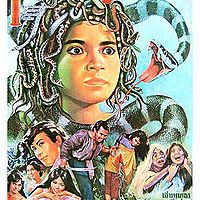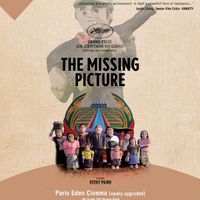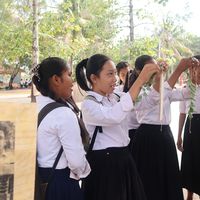National Museum of Cambodia
 (Image from Wikipedia)
The history of the National Museum of Cambodia goes back to the early 20th century. It was inaugurated on 13 April 1920 under the patronage of King Sisowath and the French Resident Francois Baudoin, and was named Musee Albert Sarraut after the Governor General of Indochina. The French archaeologist George Groslier (1887-1945) was the prime force in the establishment of the museum and he also designed the museum building. In 1951, the control of the Museum was handed to the Cambodians and in 1966, the first Cambodia Director, Chea Thay Seng was appointed. During the period of Khmer Rouge control, the museum was closed from 1975 to 1979. It suffered neglect and many staff members lost their lives. After liberation, the museum was quickly tidied up and reopened on the 13 April 1979.
The museum houses one of the world's greatest collections of Khmer cultural artefacts including sculpture, ceramics and ethnographic objects from the prehistoric, pre-Angkorian, Angkorian and post-Angkorian periods.
The Museum promotes awareness, understanding and appreciation of Cambodia's heritage through the presentation, conservation, safekeeping, interpretation and acquisition of Cambodian cultural material. It aims to educate and inspire its visitors.
(Image from Wikipedia)
The history of the National Museum of Cambodia goes back to the early 20th century. It was inaugurated on 13 April 1920 under the patronage of King Sisowath and the French Resident Francois Baudoin, and was named Musee Albert Sarraut after the Governor General of Indochina. The French archaeologist George Groslier (1887-1945) was the prime force in the establishment of the museum and he also designed the museum building. In 1951, the control of the Museum was handed to the Cambodians and in 1966, the first Cambodia Director, Chea Thay Seng was appointed. During the period of Khmer Rouge control, the museum was closed from 1975 to 1979. It suffered neglect and many staff members lost their lives. After liberation, the museum was quickly tidied up and reopened on the 13 April 1979.
The museum houses one of the world's greatest collections of Khmer cultural artefacts including sculpture, ceramics and ethnographic objects from the prehistoric, pre-Angkorian, Angkorian and post-Angkorian periods.
The Museum promotes awareness, understanding and appreciation of Cambodia's heritage through the presentation, conservation, safekeeping, interpretation and acquisition of Cambodian cultural material. It aims to educate and inspire its visitors.
The Museum believes that Cambodia’s cultural heritage is of great value and can provide a source of pride and identity to the Cambodian people who have lost so much in recent decades.Collection Size: about 14,000 objects
View all Asia-Europe Museum Network members from Cambodia
Similar content
08 Apr 2018 - 22 Jul 2018
By Jérémy Segay
03 Oct 2005
13 Feb 2013
posted on
22 Aug 2013
from - to
14 Jan 2012 - 29 Jan 2012
By Tola SAY
18 May 2021




